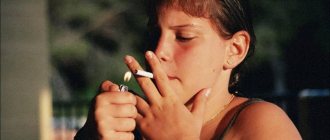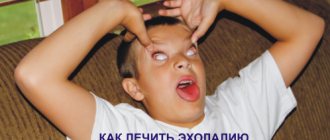An aggressive child is not a rare phenomenon in the modern world.
Unfortunately, for many parents this is a big problem that they face at home when raising their child, as well as in the children's group, when their beloved baby is in the same territory with a child who is showing aggression.
“What is the danger of aggression?”, “How to help a child with aggressive behavior?” – we will try to answer these and other questions in this article.
Portrait of an aggressive child
It is quite difficult not to notice a child with aggressive behavior. Often this is a pugnacious and rude child who can attack and hit a peer or parents, breaking toys, screaming or purposefully using rude language.
An aggressive child becomes a big problem for parents, educators, and teachers. It is very difficult to accept such a “difficult” child, and it is even more difficult to understand the reason for such behavior.
Aggressive behavior in children is a “cry for help” and a unique method of attracting attention. Such a child “signals” that he needs love and affection, understanding and acceptance. With the help of aggression, he makes it clear that he is experiencing internal discomfort, that he feels rejected and forgotten.
Indifference and cruelty on the part of parents can lead to problems in parent-child relationships, the result of which is the child’s belief that he is not loved. In order to change the current situation and “earn” the love of their parents, children try to attract their attention in any way, including aggressive behavior. If a child feels that he is vulnerable, if he is not confident in himself, if he cannot join the children’s team and feel like “he belongs” there, then aggression on the part of such a child will not be long in coming.
Such children most often cannot evaluate their aggressiveness; they do not notice that this form of behavior leads to some negative consequences. They are anxious, fearful, and it seems to them that the whole world is against them.
It is very important that parents and teachers understand the difference between “aggression” and “aggressiveness”:
- Aggression is a “one-time” act of a child that violates moral and ethical standards and can lead to moral or physical harm to others.
- Aggression is a form of behavior that becomes “habitual” over time.
Fighter Misha: too much energy
Mishka is 5 years old and he is a fighter.
He happily gives commands to his family, and they have already realized that sometimes it is easier to obey than to come to an agreement. Nevertheless, the whole family puts up strong resistance to Mishka. Through joint efforts, resorting to telephone conversations with his strict father, and even physical punishment, we still manage to put him to bed during the day and evening, force him to remove the toys lying around the house, and behave quietly at the table, obeying the general regime of life in family. Since the problems began from birth, the family lives in a grave premonition of the pathology of the child’s development. In addition, antipsychotics radically relieve the sleep problem. By the time they contacted a psychologist, the parents had already registered the boy with a neurologist and psychiatrist.
What's happening . People who have a strong choleric temperament are characterized by endurance, assertiveness, high physical tone, the need for physiological satisfaction, and high excitability. Temperament is genetically determined. It cannot be fixed, but you can learn to cope with the problematic side.
First: choleric people need additional physical activity; it is important for them to move as much as possible. If parents restrain, “fetter” the child, the need for movement grows rapidly, and the “release” will become too intense.
Second: choleric people are expansive. They do not like obstacles and try to occupy as much space as possible. That's why toys are scattered everywhere.
The third feature: dominance. The best conditions for choleric people are a hierarchy, which is built on the principle “whoever is stronger is in charge.” The father’s authority is unshakable, but the rest of the family members are tested “weakly.” We are not advocating physical punishment, but sometimes you need to demonstrate strength by simply grabbing a child tightly by the wrist, or breaking a stick in front of him, or making a threatening face.
Children with choleric temperament are sensitive to strong signals. They do not take weak incentives, dull conversations about the moral side of the issue, requests for pity seriously. They do not listen to those who are weaker than them. Choleric children need not so much rest as additional stress and stress. They are real marathon runners.
Types of aggression
Among the types of aggression the following can be distinguished:
Verbal aggression
This type of aggression manifests itself in verbal form: an elevated tone of conversation, turning to shouting, insults and humiliation, and even threats are possible.
Physical aggression
This type of aggression is manifested in specific physical impact towards a person or causing damage to someone else’s property: bites, beatings, damage to various things, equipment, etc.
Direct aggression
A type of aggression that is directed at a specific object.
Indirect (indirect) aggression
With this type of aggression, a child can gossip, use malicious jokes, and provoke.
Auto aggression
This type of aggression that a child uses against himself. It manifests itself in tearing out hair, eyelashes, eyebrows, biting nails, and frequent trauma.
How to understand that your child is behaving aggressively: symptoms and signs, diagnosis
What parents should pay attention to in their child’s behavior:
- the child cannot control his words, actions, emotions, and behavior in general. In rare cases, he may try to take control of his behavior, but nothing comes of it;
- the child often quarrels with peers and adults, deliberately enters into arguments with them and sorts things out;
- breaks toys, destroys buildings made by others; loves to spoil other people's things and at the same time takes obvious pleasure;
- does not respond to requests, instructions and violates established rules;
- deliberately does “bad” things to cause a negative reaction;
- remembers the insult and the offender, often wants to take revenge on the offender;
- cannot admit his mistakes, always tries to justify himself or blame someone else.
Children, especially preschool age, are characterized by disobedience. If there is a serious reason for this (unfair punishment, resentment), then the child’s anger and aggression are completely justified, and in such cases it is considered an absolutely normal reaction of the child.
Parents should take action only if they notice at least several of the above signs in their child regularly (from six months).
Diagnostics
If there is any doubt about the child's level of aggression, parents should pay special attention to his drawings, because they can be very informative. It may be time to seek help if your child:
- depicts himself as a small figure (relative to other objects in the picture);
- draws himself in a “closed” pose (an elongated, angular figure with his hands pressed to his body or hidden behind his back);
- draws himself with large eyes, with clearly drawn pupils;
- clearly draws teeth and nails;
- draws weapons;
- fire;
- huge hands, fists;
- regularly “forgets” to draw one of the family members or leaves this figure unpainted;
and:
- if there are many corrections in the drawing;
- the lines of the drawing are weak or there are no clear contours.
Diagnosis of a child’s aggressive behavior should be carried out by specialists (psychologist, psychotherapist, neurologist). The main goal of such a diagnosis is to find out the cause of aggressive behavior, to understand why, why and what he is protecting himself from. It is also necessary to clarify what “resources” this child has, so that they can be “relyed on” in solving this problem.
Research instinct
The child is a little destroyer.
New parents are forced to change the space to protect the baby and valuable items. Thus, the behavior of a child exploring the world around him can be called aggressive. After all, he invades the boundaries of others, his behavior is not yet mediated by social norms, and he does not understand which of his actions are acceptable and which are not.
And the task of the environment in this case is to cope with such aggression, adapt, and become a container for the child’s aggression.
Manifestation of aggression at different ages
The manifestation of aggression in children can be seen at different age stages:
Infancy
Babies show their aggression when they are hungry, experience pain, discomfort, or are in an uncomfortable position.
Early childhood
Young children are prone to aggression:
- to an adult and this is connected with the achievement of some goal;
- to a newborn brother or sister, as the feeling of fear of losing maternal love and the feeling of jealousy intensifies;
- After a three-year crisis, aggression usually “subsides.”
Preschool age
Hostility towards peers appears. Aggression can manifest itself as a reaction to insult.
School age
At this age, aggression is most often manifested in verbal form to protect one’s interests (insults, curses) or to get out of isolation. Through aggression, a student can express resentment and fear.
Adolescence
In adolescence, the manifestation of aggression is indicative: “I’m an adult and I can afford it!” Most often, aggression is shown by leaders and/or outsiders, since aggression in this period is closely related to communication with peers.
What is aggressiveness?
The word "aggression" is of Latin origin and literally means "attack." Aggression in children is not uncommon, but adults are also susceptible to similar behavior. Its main problem is an acute contradiction to the norms established in society. Aggressive behavior causes psychological discomfort in others and often causes physical, moral and material damage. The aggressiveness of children is something that cannot be tolerated, because the behavior of young children can be controlled, but growing up, an aggressive child turns into an aggressive adult and poses a threat to others.
Causes of childhood aggression
Emotional abyss
If the parents and the child have not established or lost a positive emotional connection, if the parents solve their problems among themselves very violently and emotionally, and the extreme option is to blame the child for their problems, then this can lead to the emergence and consolidation of aggression in the behavior of children.
There are two possible scenarios leading to aggression:
- Imitation . When aggression is perceived as an acceptable behavior option and a learned way of solving problems.
- Loss of secure attachment (when there is no contact). If contact between parent and child is lost or was not established from the very beginning, the manifestation of aggression in the child’s behavior will not take long to occur.
Disrespect for the child's personality
If an adult (especially parents) allows himself insults, humiliation, and incorrect statements towards a little person, then this leads to the development of deep complexes. The result of such communication can be not only aggression, but also outbursts of severe rage.
Low self-esteem
One of the reasons for a child’s aggressive behavior may be low self-esteem.
If a child is not confident in himself, then he is not confident in those around him. Low self-esteem “pictures” in the imagination a danger that can come from peers, parents, and teachers. In such cases, the child, without waiting to be offended, begins to behave aggressively himself, thus preventing an invented attack “from outside.”
If such children, due to low/low self-esteem, do not have the opportunity to receive emotional support from their parents, then there is a possibility that the child will make a choice in favor of an aggressive form of behavior.
Hyper and hypoprotection
A complete lack of control, as well as its excessive manifestation, carry a great danger of influencing the child’s behavior patterns and, in particular, the level of manifestation of aggressive behavior. Excessive control on the part of parents can give rise to fear and anxiety, which, when accumulated in the child, will lead to an inevitable protest against existing rules. Often this happens in the form of aggression.
Give your child more freedom while ensuring his complete safety. Install the “Where are My Children” application from the AppStore and GooglePlay stores.
To be the best
The desire to be the best among their peers often pushes children to display aggressive behavior.
Modern heroes of cartoons, feature films, documentaries, and computer games, regardless of whether they are positive or negative, carry aggression within them. Often on screens we see the use of force for supposedly “good” purposes. Adults understand that this is an extreme option for solving their situation, but the child reads this message as a call to act in a similar way in any situation. They consider this path the most convenient in achieving a certain status among their peers.
In such cases, it is important to explain to the child that there are different ways to achieve leader status: for example, through abilities and hobbies.
"Like everyone else"
Nowadays, when a child finds himself in one society or another, the children’s team sees different options for behavior. If aggressive behavior is “supported” in the class, then in order not to stand out and be an outsider, it is easier for a child to put on a “mask of aggression” than to fight such “norms.” The pressure that a class puts on a child can be compared to the phenomenon of a crowd - it is difficult even for an adult to resist such pressure, not to mention children.
We should not forget about such reasons as overwork, a ban on physical activity, excessive consumption of certain foods (chocolate, caffeine, etc.), air temperature, noise level, etc.
How does injury form?
Some unrestrained adults begin to shout at the child, furiously tearing the torn passport out of his hands, slapping him on the bottom, taking him to another room and isolating him, thereby punishing him for the offense.
This behavior frightens the child. He is not yet able to realize that he has committed a crime on a local scale. For him there is no difference between a passport and a book that can be ruffled.
It is the parent’s job to understand this. . Learn more about how a child copes with his aggressive feelings if his parents do not help him.
A scream has a much more traumatic effect on a baby than we might imagine. This is a danger signal.
The child does not yet understand all the words, but he reads emotions perfectly. Seeing his mother’s face twisted with rage, he falls into horror. This situation can easily be considered an early injury.
How to deal with childhood aggression - advice from a psychologist
A parent needs to know some truths that will help him in the fight against child aggression:
Exit, not suppression
It is always important to give vent to emotions without “squeezing” them or “suppressing them.”
Parents themselves must learn this, and only then teach it to their children. If you are angry, don't be afraid to tell your child about it. This is fine. This way you talk through the problem and it becomes easier for you. At the same time, you show the child that he can do the same thing - talk about what he doesn’t like, that he’s angry or upset about something. Gradually, the child will master this “maneuver” and understand that it is much easier to talk about the problem than to try to attract attention with his terrible behavior.
Correct example
It is important that your words do not diverge from your actions. Be aware of this. Do not demand from your child what you cannot do yourself.
If you want your child to express his emotions in an environmentally friendly way, pay attention to how his environment does this, and first of all, you, the parents.
If you have difficulty expressing your aggression and cannot “accept” your child’s aggressive behavior, then perhaps you should consult a psychologist.
Aggression is inevitable
If an “attack” of aggression has already begun, the child is screaming, trying to hit, then the best option is a tight hug. When he calms down, you can tell him that you are ready to listen to him whenever he feels bad. It is better to talk with the child at such moments without strangers and without emotionally charged words and expressions.
Methods for correcting aggressive behavior
All parents who are faced with aggressive behavior of a child are interested in the question: “How to correctly approach the correction of such behavior?”
It should be noted: in order for a sustainable result to be seen, it is necessary that the correction is not episodic, but permanent and comprehensive.
The most popular methods of correcting aggressive behavior, especially in preschool age, include art therapy in all its diversity:
- isotherapy (you can use various drawing methods: blot therapy, drawing with fingers, palms, feet);
- sand therapy;
- clay therapy;
- puppet therapy (you can purchase or sew dolls yourself for a puppet or finger theater, or make paper figurines for a tabletop theater);
- fairy tale therapy (writing fairy tales by the child himself and for the child. It is important to offer the child a role with a positive power characteristic, for example: knights, heroes, etc.);
- dance therapy, etc.
You should pay attention to outdoor games that help relieve tension and neutralize aggression; games to develop a child’s communication and positive behavior model, games to develop empathy and a relaxation orientation.
To release accumulated aggression, the child can be offered:
- crumple and tear paper;
- fight with a pillow or punching bag;
- use a "scream bag/cup";
- use inflatable batons, water gun, trampoline;
- kicking a tin can;
- rub plasticine into cardboard.
Parents' mistakes
The following factors can influence the formation and consolidation of aggressive behavior in children:
- low degree of family cohesion;
- inadequate style of family education (hypoprotection, overprotection);
- different parenting styles;
- demonstration of a model of aggressive behavior (parents to children, father to mother, etc.);
- encouraging aggressive tendencies in children's behavior;
- indifferent attitude towards the child’s social success;
- use of physical punishment;
- threats, “verbal violence”;
- introducing any restrictions;
- complete lack of encouragement;
- lack of attention to education and intrafamily communication;
- excessive control/lack of control;
- lack of emotional contact;
- underestimation of the role of parents' personal example;
- “life for the sake of children”;
- uncontrolled use of gadgets.
Emotionally volitional disorders in children.
The formation of the emotional-volitional sphere is one of the most important conditions for the formation of a child’s personality, whose experience is continuously enriched. The development of the emotional sphere is facilitated by family, school and life, which surrounds and constantly influences the child. Emotions play a significant role from the very beginning of a baby’s life, serve as an indicator of his relationship with his parents, and help him learn and respond to the world around him. Currently, along with general health problems in children, experts note with concern the increase in emotional-volitional disorders, which result in more serious problems in the form of low social adaptation, a tendency to antisocial behavior, and learning difficulties.











